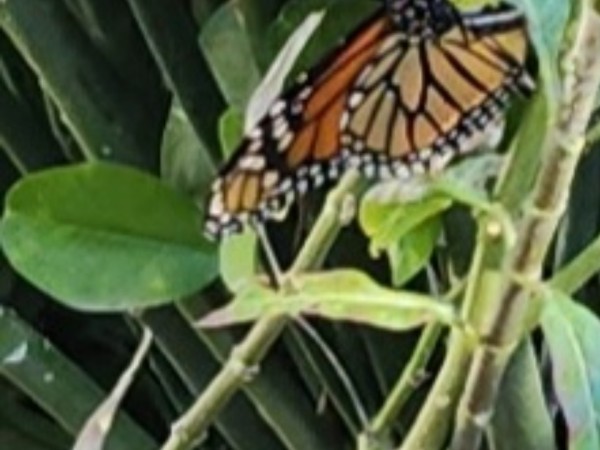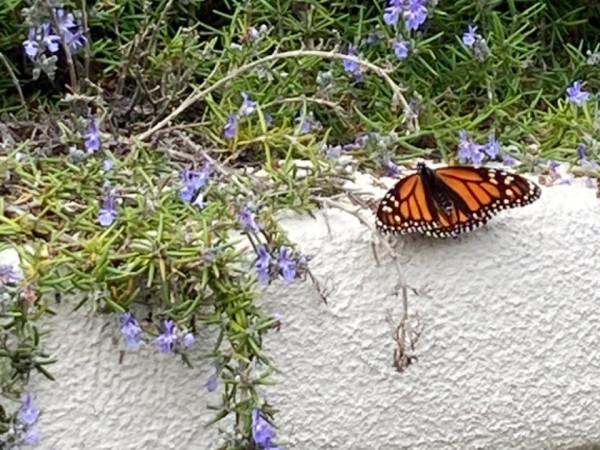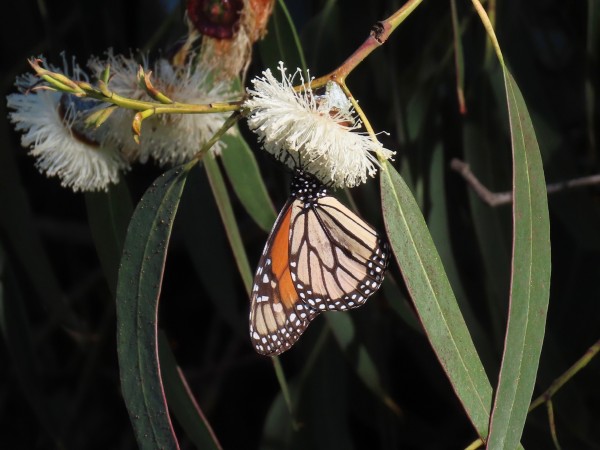2024 Spring Letter #2: Western Monarch Population News From Gail Morris
Spring Migration Begins
Monarchs are rapidly leaving their winter homes along the California coast on their journey to the summer breeding areas. They are mating and laying eggs as they move through the Western landscape. But a late-season cold storm front may present a challenge. The National Weather Service is forecasting an intense cold weather systems could move into California on Thursday through the weekend. If the trajectory of this front continues as forecasted, the Sierras could be blanketed with deep snow, and in time snow levels may drop to the lower altitudes with frost possible in nearby Valleys. Keep an eye on the weather.
Be sure to report any milkweed up and monarch sightings to Journey North—whether they are adults, eggs or larvae. Provide as much information as you can such as weather conditions (it’s okay to estimate). Your detailed description of what you see can include, but is not limited to, the monarch’s gender and activity and, if known, the type of flowers if they are nectaring.
Recent Sightings
Your sightings can help us all see where milkweed is up and the weekly monarch movement as the Spring Migration unfolds. Adding a few words or sentences about your observations can help everyone learn about the best milkweed and flowers to plant to help monarchs on their way!
David spotted 3 monarchs in Desert Hot Springs, California, on January 30.
Jan observed a monarch while out for a walk in Oakland, CA. towards Washington St so it flew in the opposite direction down the paved sidewalk path I was on. You possibly could say it was flying southeast. (02/28/2024)
Monica in San Diego, CA observed her first female monarch butterfly as it was enjoying a sunny and dry day. (02/27/2024)
Be sure to visit the Journey North Maps for more information about monarch and milkweed sightings at this link.
Reports from the Field
A Bittersweet End to Overwinter at Pacific Grove, California by Stephanie Turcotte
Stephanie Turcotte reports that from February 16th to February 23rd, 2024, observations in Pacific Grove, CA, revealed notable shifts in monarch butterfly behavior and population from previous years. Despite relatively mild weather storm fronts still moved through the area. Turcotte observed mating activity and monarchs flying outside their habitat, behavior usually not seen until mid-March. By February 23rd, it appeared that the overwintering season had come to a sudden end, with only 59 monarchs clustered on two trees and no monarchs observed flying. Turcotte hopes for a productive breeding season for the western monarch population and will wait for the monarchs to return in October.
- Read Stephanie Turcotte's full report here
February 16, 2024: This week’s weather was relatively insignificant compared to what we had experienced previously, temperatures were mild, and we had plenty of sunny afternoons to prompt mating activity in the Pacific Grove habitat. I saw evidence of that while taking kindergartners through mid-week. I also observed monarchs flying westerly outside the habitat, gathering nectar and sunning in trees beyond the grove. This type of activity I usually see at the end of the season. Last year, that didn’t happen until late in March. We were still counting until mid-March, which wasn’t typical. However, we also had much colder temperatures here and in the surrounding areas at that time, which as you know, can impact the timing of the monarchs leaving the area.
Yesterday, 2/16/24, we (again) had to search for the monarchs in the grove. It is a ‘fun’ aspect of counting them…. finding where they are. For a split second, you think they may have all left, although not likely that ALL 2,500 from the previous week departed. We found them HIGH up in the Monterey pines and cypress located in the north/northwest of the grove for this count, mostly on the easterly sides of the trees, closer to the nectar beds and positioned to receive the sun at the earliest time possible. We counted 1,250 total in 6 trees, 1,246 clustered. One cypress had 345 monarchs, and another had 707. Fortunately, we counted these trees first because shortly after we finished, there were two beautiful ‘bursts’ from both trees, one after the other. I consider this one of the gifts you receive while counting. Regardless of what your driving discipline might be, we all just stop and marvel at it.
We are bracing for one more storm here this weekend, when and how much wind and rain is still in question. We will count again next week and see how many monarchs ‘weathered’, hopefully, the last of our storms. For those monarchs that made it out to the breeding habitats, hopefully, they have the protection they need for the next few days.”
February 23, 2024: Gail Morris put it so well when she mused that it must be bittersweet for those of us at overwintering sites who come to the end of the monarch season. Last year, it was a gentle end to the season which made it much easier to move through than this season, which ended so abruptly for us in Pacific Grove, CA. We experienced some beautiful, sunny days here since last week’s count. I saw plenty of mating pairs flying off into the trees, even with the low numbers left in the grove. Even so, I hoped that a few hundred would stay around a little longer. However, this morning we only counted 59 monarchs clustered on 2 trees, one Monterey pine in the interior and the rest on a Cypress in the northern end. There were no flyers and no grounders. It was a cool 46 degrees, a slight breeze, and quiet. It’s possible that there were more monarchs high up in the canopy where we couldn’t see them even with binoculars- but we end our season with this count.
Now we wait and see what happens with the subsequent spring, and summer generations and hope that we have monarchs inhabit our grove again next October.
Fluctuating Monarch Numbers, Lighthouse Field, Santa Cruz, California by Diana Magor
Diana Magor reports monarch behavior during the period from February 15th to February 22nd, 2024. observations at Lighthouse Field revealed fluctuations in monarch butterfly numbers and behaviors. On February 15th, despite cold temperatures, a significant increase in monarch numbers was counted, with thousands clustered primarily on Monterey Cypress trees, suggesting potential migration patterns and mating activity spurred by warmer conditions. However, by February 22nd, the count dropped significantly to 2,211, possibly influenced by warmer weather and mating behavior. Concerns arose regarding monarchs mating on the gravel path, posing risks to monarchs from pedestrian and cyclist traffic despite efforts to warn passersby. Overall, these observations suggest dynamic responses to environmental conditions and potential changes to migration patterns among the western monarch populations in the region.
- Read Diana Magor's full report here
February 15, 2024: On Thursday, February 15, 9:50 AM, I visited Lighthouse Field to do a monarch count. It was mostly sunny but cold (53°F). I expected to find fewer monarchs than at my last count on Feb 8. To my surprise, there were thousands (5,676) of monarchs inside the center of the grove in large clusters, mostly on the South and East sides of 1 Monterey Cypress, which I refer to as Tree 7. The sun was just beginning to reach some of the clusters. Only a handful were flying outside the grove. The remaining 1,307 were on the south-facing side of the 3 large Monterey Cypress on the south side of the grove. I initially saw only two or three flyers and two grounders, for a total of 6,983, which was 2,200 higher than the total of 4,783 1 week earlier.
As the day warmed, mating began in earnest. I observed and photographed 15 matings in 30 minutes, and more were occurring as I was photographing and following these 15. They occurred mostly on the new gravel road that had recently been installed adjacent to the Grove. I suspect that the gravel was warmer than the grass, and it was more difficult for males to take off carrying their females in the grass.
I hypothesize that the increase in numbers at Lighthouse Field may be due to monarchs overwintering in other groves moving to Lighthouse Field, which has a larger number of Monterey Cypress than at many other groves. The Monarchs at Lighthouse Field use only Monterey Cypress, not eucalyptus, during storms. Stephanie Turcotte reported the count at Pacific Grove the morning after my count was only 1,250, down from 2,500 the previous week. She noted that she observed monarchs “flying westerly outside the habitat” which suggests they may have been in the process of migrating and stopped off in Santa Cruz. Another storm was coming in on Saturday.
I am not finding any dead monarchs at Lighthouse Field except for the few that drowned in puddles after the huge Feb 4 storm, so this habitat seems to be an important and safe one for them. They are still nectaring from the Eucalyptus flowers, which are and have been abundant. Several monarchs from more southerly overwintering sites may end up “roosting” or continuing to overwinter at more northerly sites along their migration routes.
The nights are still quite cold here, and the storms continue this week, so I suspect that many monarchs will migrate in the next couple of weeks. Attached is a photo of one of the clusters, and 1 of a monarch nectaring.
February 22, 2024: The monarch count at Lighthouse Field on Thurs, 2/22/24 at 8:10 am, temp 50°F was 2,211, a significant drop from the previous week’s larger-than-expected 6,983. There had been several warmer days with sunshine over the last week, with only a little rain. 1,871 were on 4 sunny South side cypress trees, most high up catching the early morning sun, with only 340 on an inside cypress, which now has more sunlight due to the big Eucalyptus fall in the storm of Feb 4, and 1 grounder, a female that couldn’t fly due to low temp. As soon as the temp warmed a bit, 5 females were taken down by males and mating began. Unfortunately, they are mating on the new gravel path directly below the largest Cypress, and pedestrians and bicyclists are not seeing them and, in some cases, stepping or cycling over them. A sign has been placed in the center of the path warning people to watch for and avoid them, but cyclists cannot see the sign or the monarchs easily.
Numbers at Pismo Monarch Grove, California
- Read full report here
On February 15, 2024, MaryLou Barker Gooden reported a count of 3,892 monarchs at Pismo Monarch Grove.
Thanks go out to both Stephanie Turcotte and Diana Magor for their reports from Pacific Grove and Santa Cruz in California.
Gail Morris is the Coordinator of the Southwest Monarch Study (www.swmonarchs.org and the Western Monarch Advocates. She is also a Monarch Watch Conservation Specialist, and the Vice President of the Central Arizona Butterfly Association. The Western Monarch Population News is based on comments provided to Gail Morris. We hope to increase the number of sightings and therefore photos and comments entered into the Journey North. We rely on the volunteers who communicate regularly with Gail and who agree to participate in our effort to increase awareness of the population of western Monarchs. You can reach her at gail@swmonarchs.org




